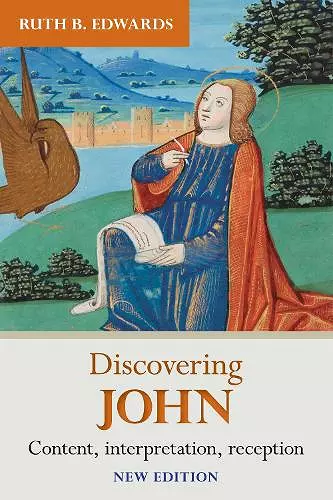Discovering John
Content, Interpretation, Reception
Format:Paperback
Publisher:SPCK Publishing
Published:20th Mar '14
Should be back in stock very soon

This introduction to the interpretation of Matthew aims to encourage in-depth study of the text, and genuine grappling with the theological and historical questions raised, by providing a 'map' to the Gospel as a whole, and to key interpreters and interpretative debates. It draws on a range of methodological approaches (author-, text- and readercentred), as complementary rather than mutually exclusive ways of interpreting the text. In particular, this new introduction reflects the growing scholarly attention to the reception history of biblical texts, increasingly viewed as a vital aspect of interpretation rather than an optional extra.
This is an expanded second edition of a shorter version of Discovering John, first published by SPCK in 2003. The new edition has the feel of a much more substantial book, being larger in all dimensions, but with more generous typesetting which makes the second edition much easier to read, it is about 60 pages longer on content, although a significant part of the extra length is absorbed in the 76 pages of notes, bibliography and index of the second edition. It is also one of the first two volumes in a wider collaboration between SPCK and Eerdmans entitled ‘Discovering Biblical texts’ which aims, according to the Eerdmans website, to ‘offer readers compact, up-to-date, and student-friendly introductions to the books of the Bible and their structure, content, theological concerns, key interpretative debates, and historical reception.’ The other volume already published is on Matthew’s Gospel, by Ian Boxall, who like Edwards has taught at Oxford University, and further studies on books such as Mark, Romans, Genesis and Exodus are promised soon. The structure and the majority of the content of the revised version of John is the same as the original with some additional material and some minor rewriting. There are the same thirteen chapters with the same titles, apart from chapter 2, where ‘The Reception of John’s Gospel’ becomes ‘Interpreting John: strategies for reading’, but even here the main contours of the two chapters are the same. What there is in addition is throughout both an account of and reference to the developing scholarship of John in the first part of the twenty-first century, and two new excursuses at the end, the first on the text of the Gospel, offering a brief overview of the transmission of the text with comments on key textual differences, and the second on the question of eye witness testimony, which is prompted by Richard Baukham’s book and engages with both his and other recent work. Edwards’ approach is firmly rooted in the historical-critical method, although alert to alternative scholarly approaches. The more narrative approach of Culpepper and Stibbe, for example, are included but overall historical issues dominate. Such an approach is probably the most sensible for the kind of book this is, but it means a reader would need to look elsewhere for significant or detailed discussion of other approaches. Table 1 at the end of the book offers an overview of the structure of the Gospel, drawing in part at least on Bultmann’s description of the two halves of the Gospel as the Book of Signs and the Book of Glory, but there is little discussion of how the Gospel as a whole might work as a narrative. The book is arranged thematically with early chapters on more background issues such as authorship, sources and intended audience, before moving onto chapters based more on the content of the Gospel – miracles, Christological titles, the passion and resurrection, the relationship between Jesus and God and other characters in the Gospel – followed by a couple of wider interpretive chapters based on the relationship between Christians and Jews, based around charge of anti-Semitism, replacement theology and the challenge to Jewish monotheism. Such a structure works well in exploring key issues which could then be explored further by engagement with a variety of commentaries on specific texts. Edwards’ approach is generally to explain the issues and set out some alternative positions rather than to argue very strongly for one particular theory or reading. So the chapter on the contested questions of place and date of authorship and intended authorship comes to the cautious conclusion that much is uncertain but the Gospel was aimed at a broad Jewish-Christian audience but within and beyond the church. Such a position is unremarkable, but to arrive this point the previous twelve pages cover significant ground both thematically and in the historical development of scholarship. Like the first edition, this is a well-written, very readable and informative book. In the vast scholarship on John – Edwards makes the well-made point in her preface that the ever increasing volume of published work makes keeping abreast of the whole field now virtually impossible – this book is an academic primer. It would be very suitable for undergraduate level students, and I have certainly used it like that. This appears to be the key market. It would alert the reader both to the important issues in the text but also to the significant areas of Johannine scholarship with the kind of engagement with the wider field that points the way for the reader to delve deeper. But it is clearly, and helpfully, an academic primer that assumes and expects the kind of level of engagement with the discipline of biblical studies provided by an undergraduate theology course. If you have the first book then there probably is not sufficient in the second edition to need it, but as a good academic introduction or re-introduction to the Gospel this would make an excellent choice. -- Anthony Clarke * Regent's Reviews *
ISBN: 9780281069699
Dimensions: unknown
Weight: unknown
276 pages
2nd edition